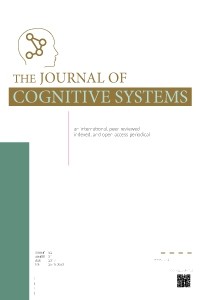DETERMINATION OF CRYPTOSPORIDIUM SPP. RISK FACTORS USING MULTILAYER PERCEPTRON NEURAL NETWORK AND RADIAL BASED FUNCTIONAL ARTIFICIAL NEURAL NETWORK METHOD
DETERMINATION OF CRYPTOSPORIDIUM SPP. RISK FACTORS USING MULTILAYER PERCEPTRON NEURAL NETWORK AND RADIAL BASED FUNCTIONAL ARTIFICIAL NEURAL NETWORK METHOD
Multilayer perceptron neural network, Radial-based function neural network, classification Cryptosporidium spp., risk factors,
___
- B. Bhattachan, J. B. Sherchand, S. Tandukar, B. G. Dhoubhadel, L. Gauchan, and G. Rai, "Detection of Cryptosporidium parvum and Cyclospora cayetanensis infections among people living in a slum area in Kathmandu valley, Nepal," BMC research notes, vol. 10, pp. 1-5, 2017.
- P. Kumar, O. Vats, D. Kumar, and S. Singh, "Coccidian intestinal parasites among immunocompetent children presenting with diarrhea: Are we missing them?," Tropical Parasitology, vol. 7, p. 37, 2017.
- D. Dirim Erdoğan, N. Turgay, and M. Z. Alkan, "Bir Cryptosporidiosis olgusunun kinyoun Asit-fast boyası ve polimeraz zincir reaksiyonu (PZR) ile takibi," Türkiye Parazitoloji Dergisi, vol. 27, pp. 237-239, 2003.
- D. P. Clark, "New insights into human cryptosporidiosis," Clinical Microbiology Reviews, vol. 12, pp. 554-563, 1999.
- M. Çuhadar, "Türkiye’ye yönelik diş turizm talebinin MLP, RBF ve TDNN yapay sinir aği mimarileri ile modellenmesi ve tahmini: karşilaştirmali bir analiz," Journal of Yasar University, vol. 8, 2013.
- S. Tuna, "Şablon eşleme ve çok katmanlı algılayıcı kullanılarak yüz tanıma sisteminin gerçeklenmesi," 2008.
- A. Auclair, "Feed-forward neural networks applied to the estimation of magnetic field distributions," 2004.
- Ç. Çatal and L. Özyilmaz, "Çok katmanli algilayici ile multiple myeloma hastaliğinin gen ekspresiyon veri çözümlenmesi."
- C.-N. Ko, "Identification of non-linear systems using radial basis function neural networks with time-varying learning algorithm," IET signal processing, vol. 6, pp. 91-98, 2012.
- O. Akbilgiç, Ğ. Danışman, and H. Bozdoğan, "Hibrit radyal tabanli fonksiyon ağlari ile değişken seçimi ve tahminleme: menkul kiymet yatirim kararlarina ilişkin bir uygulama."
- B. K. Wong, T. A. Bodnovich, and Y. Selvi, "Neural network applications in business: A review and analysis of the literature (1988–1995)," Decision Support Systems, vol. 19, pp. 301-320, 1997.
- E. Öztemel and Y. S. Ağları, "Papatya yayıncılık," İstanbul, 2003.
- M. D. Buhmann, Radial basis functions: theory and implementations vol. 12: Cambridge university press, 2003.
- U. Okkan and H. yıldırım Dalkiliç, "Radyal tabanlı yapay sinir ağları ile Kemer Barajı aylık akımlarının modellenmesi," Teknik Dergi, vol. 23, pp. 5957-5966, 2012.
- C. Cetinkaya, "Retina Görüntülerinde Radyal Tabanlı Fonksiyon Sinir Ağları İle Damar Tipik Noktalarının Tespit Edilmesi," Ege Üniversitesi Uluslararası Bilgisayar Enstitüsü, YL Tezi, 2011.
- S. Özçelik, Ö. Poyraz, K. Kalkan, E. Malatyalı, and S. Değerli, "The investigation of Cryptosporidium spp. prevalence in cattle and farmers by ELISA," Kafkas Üniversitesi Veteriner Fakültesi Dergisi, vol. 18, 2012.
- J. K. Griffiths, "Human cryptosporidiosis: epidemiology, transmission, clinical disease, treatment, and diagnosis," in Advances in parasitology. vol. 40, ed: Elsevier, 1998, pp. 37-85.
- D. Miron, J. Kenes, and R. Dagan, "Calves as a source of an outbreak of cryptosporidiosis among young children in an agricultural closed community," The Pediatric infectious disease journal, vol. 10, pp. 438-441, 1991.
- G. Börekçi, F. Otağ, and G. Emekdaş, "Mersin’de bir gecekondu mahallesinde yaşayan ailelerde Cryptosporidium prevalansı," İnfeksiyon Derg, vol. 19, pp. 39-46, 2005.
- Z. Egyed, T. Sreter, Z. Szell, and I. Varga, "Characterization of Cryptosporidium spp.—recent developments and future needs," Veterinary parasitology, vol. 111, pp. 103-114, 2003.
- M. Kayri and Ö. Çokluk, "Examining Factors of Academic Procrastination Tendency of University Students by using Artificial Neural Network," International Journal of Computer Trends and Technology, vol. 34, pp. 1-8, 2016.
- L. Nanni, C. Fantozzi, and N. Lazzarini, "Coupling different methods for overcoming the class imbalance problem," Neurocomputing, vol. 158, pp. 48-61, 2015.
- A. Sarmanova and S. Albayrak, "Alleviating class imbalance problem in data mining," in 2013 21st Signal Processing and Communications Applications Conference (SIU), 2013, pp. 1-4.
- ISSN: 2548-0650
- Yayın Aralığı: Yılda 2 Sayı
- Başlangıç: 2016
- Yayıncı: İstanbul Teknik Üniversitesi
Zeynep TUNÇ, İpek BALIKÇI ÇİÇEK
COMPARISON OF DIFFERENT DECISION TREE MODELS IN CLASSIFICATION OF ANGINA PECTORIS DISEASE
İpek BALIKÇI ÇİÇEK, Zeynep KÜÇÜKAKÇALI, Emek GÜLDOĞAN
CLASSIFICATION OF CORONARY ARTERY DISEASES USING STACKING ENSEMBLE LEARNING METHOD
ARTIFICIAL NEURAL NETWORKS BASED-PREDICTION OF AUTISM SPECTRUM DISORDER
İpek BALIKÇI ÇİÇEK, Zeynep KÜÇÜKAKÇALI, Cemil ÇOLAK
Ulku KARAMAN, İpek BALIKÇI ÇİÇEK
CLASSIFICATION OF HYPOTHYROID DISEASE WITH EXTREME LEARNING MACHINE MODEL
İpek BALIKÇI ÇİÇEK, Zeynep KÜÇÜKAKÇALI
ASSESSMENT OF ASSOCIATIVE CLASSIFICATION APPROACH FOR PREDICTING MORTALITY BY HEART FAILURE
Zeynep TUNÇ, İpek BALIKÇI ÇİÇEK, Emek GÜLDOĞAN, Cemil ÇOLAK
Yeşim AKSOY DERYA, Cemil ÇOLAK, Burcu KAYHAN TETİK, Ayşe Nur YILMAZ, Zeliha ÖZŞAHİN
